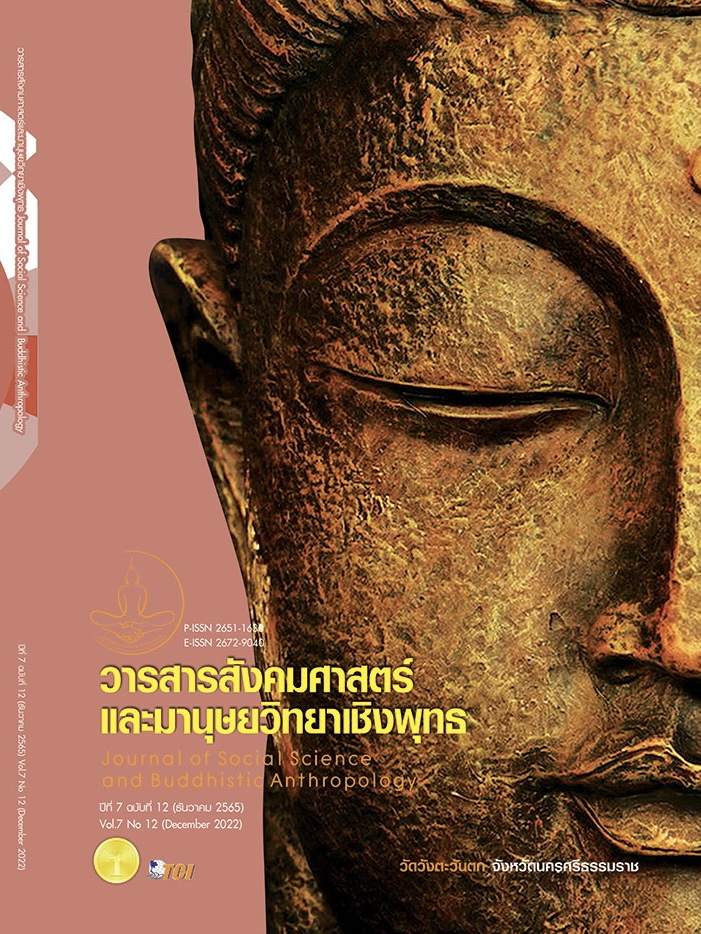ETHNOGRAPHY OF COMMUNICATION: IMPLICATION FOR CHANTING THE PHRA MALIA, SURATTHANI PROVINCE
Keywords:
the Phra Malia, Ethnography of Communication, Suratthani provinceAbstract
This research aims to apply the concept of ethnography of communication to chanting Phra Malai in Surat Thani province. It is a qualitative research. The population and groups of key informants were 5 people who chanted Phramalai chanting and the audience group. This paper uses Dell Hymes' SPEAKING framework to analyze the communication situation of chanting Phra Malia. In thos regard educational institutions are classified into 3 communication event at funerals, public and private events. It employs a qualitative research method by collecting data from documents, video recordings of Phra Malia chant, and field data collection, along with field observations. The results using descriptive analytics. The finding shows that chanting Phra Malai is a type of communication for specific groups. A person who performs this duty require a good command of speech acts. Due to the chanting of Phra Malia at funerals, government and private events have different characteristics. Therefore, it is essential that those who chant Phra Malia must study and understand nature of the event starting from the scene, communicators, purpose of the event, speech acts sequence, intonations, tools of communication, norms of interaction, and types of communication in each pattern of Phra Malia chant in different situation. This will enable Phra Malia House to plan for the preparation of the duties to go well and also helps to create a good understanding between the audience and event host.
References
ฉัตรวรุณ ตันนะรัตน์. (2519). หลักวาทการ. กรุงเทพมหานคร: มหาวิทยาลัยรามคำแหง.
น้ำผึ้ง มโนชัยภักดี. (2554). การแสดงลำตัดคณะหวังเต๊ะ: การศึกษาตามแนวชาติพันธุ์วรรณนาแห่งการสื่อสาร. ใน วิทยานิพนธ์อักษรศาสตรมหาบัณฑิต สาขาภาษาไทย. มหาวิทยาลัยศิลปากร.
นิธิ เอียวศรีวงศ์. (2538). ชาติไทย เมืองไทย แบบเรียนและอนุสาวรีย์: ว่าด้วยวัฒนธรรม รัฐ และรูปแบบจิตสำนึก. กรุงเทพมหานคร: มติชน.
ภัครพล แสงเงิน. (2562). ลักษณะสำคัญของพระมาไลย ฉบับหอสมดุแห่งชำติกรงุปารีส. วารสารมนุษยศาสตร์วิชาการ, 26(2), 285-315.
มณฑาทิพย์ ศิริพันธ์ . (2554). การแสดงโนราคณะละมัยศิลป์: การศึกษาตามแนวชาติพันธุ์วรรณนาแห่งการสื่อสาร. ใน วิทยานิพนธ์อักษรศาสตรมหาบัณฑิต สาขาภาษาไทย. มหาวิทยาลัยศิลปากร.
มัลลิกา มาภา. (2553). การสวดสรภัญญะของจังหวัดนครพนมตามแนวชาติพันธุ์วรรณนาแห่งการสื่อสาร. ใน วิทยานิพนธ์ศิลปศาสตรมหาบัณฑิต สาขาวิชาภาษาไทย. มหาวิทยาลัยศรีนครินทรวิโรฒ.
ศุภมน อาภานันท์. (2554). การแสดงลิเกคณะทวีป-ชัยณรงค์ วงศ์เทวัญ: การศึกษาตามแนวชาติพันธุ์วรรณนาแห่งการสื่อสาร. ใน วิทยานิพนธ์อักษรศาสตร์มหาบัณฑิต สาขาภาษาไทย. มหาวิทยาลัยศิลปากร.
อมรา ประสิทธิ์รัฐสินธุ์. (2556). ภาษาศาสตร์สังคม. (พิมพ์ครั้งที่ 4). กรุงเทพมหานคร: สำนักพิมพ์แห่งจุฬาลงกรณ์มหาวิทยาลัย.
อร่ามรัศมิ์ ด้วงชนะ. (2538). การศึกษาประเพณีสวดพระมาลัยของชาวอำเภอไชยา จังหวัดสุราษฎร์ธานี. ใน วิทยนิพนธ์ศิลปศาสตร์มหาบัณฑิต สาขาวิชาไทยคดีศึกษา. มหาวิทยาลัยทักษิณ.
Hymes, D. (1974). Foundation in sociolinguistic an ethnographic approach. Philadelphia: University of Pennsylvania Press.
Downloads
Published
How to Cite
Issue
Section
License

This work is licensed under a Creative Commons Attribution-NonCommercial-NoDerivatives 4.0 International License.








